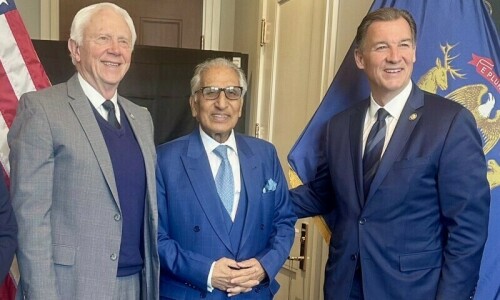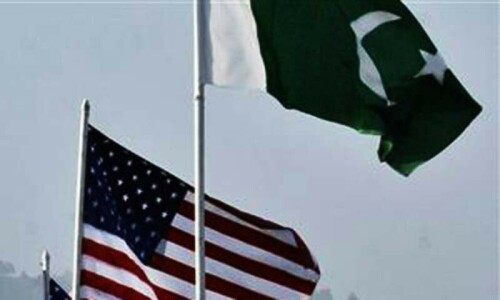 ISLAMABAD, Oct 28: The army announced on Tuesday it had halted construction of a new General Headquarters (GHQ) in Islamabad because of the economic crisis faced by the country.
ISLAMABAD, Oct 28: The army announced on Tuesday it had halted construction of a new General Headquarters (GHQ) in Islamabad because of the economic crisis faced by the country.
“The project of new GHQ’s construction in Islamabad has been suspended on the directives of Chief of the Army Staff General Ashfaq Parvez Kayani,” said a statement issued by the Inter-Services Public Relations (ISPR). It said the army shared the nation’s quest fore conomic stability through a spirit of sacrifice.
The Rs60 billion project was inaugurated by former president and army chief Gen (retd) Pervez Musharraf in Sept 2004, but the actual work began in 2007. Political parties, including the Pakistan People’s Party and Pakistan Muslim League-N, have criticised the project and called it a Pentagon-style military headquarters.
Official sources said that about 10 per cent work on the Defence Complex Islamabad had already been completed. The project is planned to be completed in three phases.
In the first two phases, the Pakistan Navy and Pakistan Air Force have already shifted to the new site, while the ministry of defence, Joint Staff Headquarters and General Headquarters are to shift in the last phase.
The sources said that about 2,500 acres of land had been acquired for the project. The GHQ will be built on 99 acres and 20 acres each are reserved for the defence ministry and Joint Staff Headquarters. Office complexes for naval and air headquarters covered about 30 and 40 acres, respectively.
Sectors E-10, D-11 and an area north of sector E-10 allotted for the Defence Services Complex constituted about 2,400 acres, including 870 acres of additional land acquired by the army in the northern side of the complex for security reasons and there will be no residential or commercial construction on the site and a green area will be maintained to ensure good environment.
The sources said that 350 acres in sectors D-11 and E-10 would remain un-utilised due to drains, mountains and other drawbacks. “This leaves only 1,500 acres for the complex. Offices for the defence ministry, Joint Services Headquarters and all Services Headquarters will be constructed on 206 acres while the rest will be used for allied facilities, including flats, houses, schools and hospitals for more than 17,000 employees.”
They said former prime minister Zulfikar Ali Bhutto had decided to shift the GHQ to Islamabad at a cabinet meeting on March 29, 1972. The shifting was first discussed after the 1965 India-Pakistan war to establish proper communication between the three services.
Critics term the relocation of army headquarters to Islamabad “wasteful and unnecessary in an era of advance communication technology” and say it will turn the federal capital into a military cantonment and put civilians at greater risk.
The Capital Development Authority is reported to have sold the prime land to the GHQ at a throwaway price of Rs180 per square yard while the market price is Rs110,000 to Rs120,000. Another about 870 acres were acquired at Rs200 per square yard in November 2004.
PPP lawmakers Farhatullah Babar and Enver Baig had submitted an adjournment motion against the project in the Senate on Nov 29, 2004. They had complained that the market price of 870 acres of land was Rs505.296 billion while it was being provided to the military authorities for only Rs842 million, causing a loss of Rs500 billion to the CDA.
The CDA has recently revised the capital’s master plan expanding the city boundaries, but details of the revised plan have not been made public and it is not clear whether the objections raised over the shifting of defence establishment during the 1987 revision of the master plan have been addressed.
The “Review of Islamabad Master Plan 1987” noted: “Sectors E-8, E-9, and E-10 have been converted from public/government employees residential sectors to armed forces (military, air force and navy) residential-cum-establishment areas which are going to overburden the communication system between the twin cities and have created public restricted areas in Islamabad’s residential areas.
“According to the original master plan concept, all army uses were assigned to Rawalpindi, where a special zone was defined for this purpose along the proposed Soan Highway and where the army has an access to the free area south-west of the city for further expansion.
“Location of defence establishment in the middle of civilian sectors has its own complications as it cannot be treated as a separate entity for planning and development. No comprehensive planning and development is possible as major road networks have to be linked across these sectors. No expansion of the area will be possible as it will be surrounded by non-defence sectors.
“In case of emergency, mobilisation will be difficult and the presence of defence establishment will constitute a serious hazard for the civilian populations that will be living around them.”














































